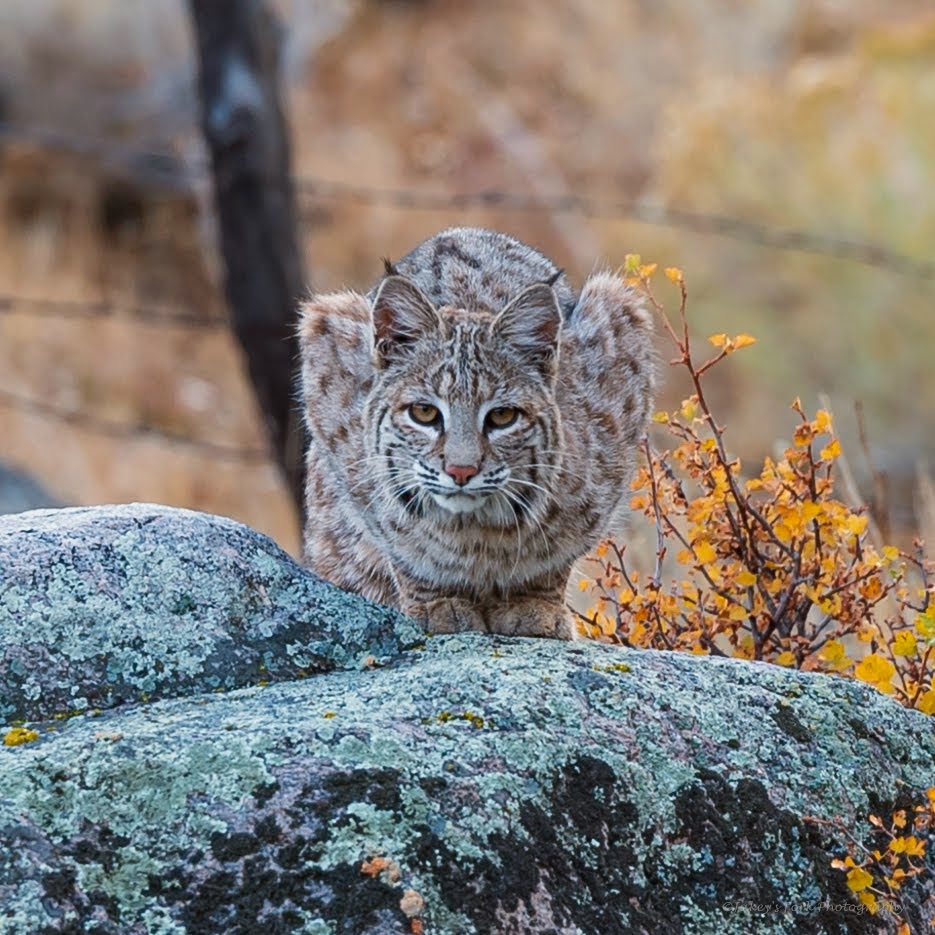Wyoming Bobcats Need a Time-Out!
No one needs to tell us that furbearers, especially bobcats, have long suffered a low priority in Wyoming’s wildlife management. Especially now! You can help us change that! Here’s an opportunity to take immediate action.
- Wyoming bobcats in Bobcat Trapping Management Area 1 (Teton County +) show a history of significant decline in bobcat harvest. Although trappers have been active in Area 1, zero bobcats have been reported trapped this season.
- Wyoming Untrapped stresses that immediate cessation of bobcat hunting, trapping and snaring is necessary to protect the existence of bobcats in this area.
Friends, relatives and colleagues of Wyoming Untrapped: NOW is the time For Last Take Action for bobcats!
Wyoming Game and Fish Department (WGFD) Bobcat Harvest Reports illustrate a significant decline in Area 1 (Teton County +) bobcat harvest. While harvest and population data are two different studies, the bobcat harvest variance is significant and suggests comparable bobcat population decline as well. In fact, the harvest decline is alarming enough to warrant closure of Area 1 bobcat trapping and hunting until professional bobcat population research supports the existence of a bobcat population that can sustain itself with the presence of human predation. The WGFD has responded with a final NO to any discussion and solution which protects Wyoming bobcats in MA 1.
We have requested the following additional data:
- WGFD equation to estimate bobcat trends statewide
- Harvest and rabbit population estimates statewide
- Bobcat MA 1 specific rabbit estimates
Until we receive and analyze this data, Wyoming Untrapped requests that the WGF Commission extend the public comment period until the analysis is complete. We stress that immediate cessation of bobcat hunting, trapping and snaring is necessary to protect the existence of bobcats in this area. Failure to act quickly removes the most effective tool we have to protect MA1 bobcats: data-informed wildlife management. We want our bobcats valued and protected on our landscapes!
The final proposal and public comments will go to the WGF Commission at the July 18-19 meeting in Rock Springs, WY.
Western Bobcats in Management Area 1 (Teton County +) Need Immediate Protection!
Please read our letter to WGFD recommending the immediate closure of Bobcat Management Area 1 (Teton County +) to all bobcat hunting, trapping and snaring until a professional bobcat population research supports the existence of a bobcat population that can sustain itself with the presence of human predation.
Deadline for Comments: June 17, 5:00 p.m.
Brian Nesvik, Director
Wyoming Game and Fish Department
5400 Bishop Boulevard
Cheyenne, Wyoming 82006
May 23, 2019
Dear Brian,
We write to you following our review of data published in Wyoming Game and Fish Department (WGFD) harvest reports1. These reports reflect that the Management Area 1 (MA1) bobcat harvest has declined to such a low number that the immediate closure of bobcat hunting and trapping in that area is warranted.
Wyoming Game and Fish Department Bobcat Harvest Reports 1 serve as a record of the continued, significant decline in the MA1 bobcat harvest. While harvest and population data are two different studies, the bobcat harvest variance between 2008-2018 suggests analogous population decline. At the same time, the value of bobcat pelts is at a historic high. This economic incentive drives more aggressive bobcat harvesting, a significant threat when harvest numbers drop to single digits, and the animals harvested include a high percentage of female and juvenile cats.
Time is of the essence. An immediate, temporary, hunting and trapping moratorium in bobcat MA1 provides timely intervention, preserving the existence of bobcats in this region. Professional bobcat population research should be conducted during the temporary closure. The area should not be opened to hunting and trapping until such research supports the existence of a bobcat population that is sustainable with the presence of human predation. Failure to act quickly removes the most effective tool we have to protect MA1 bobcats, data-informed wildlife management.
Failing to amend management practices invites catastrophic decline of the bobcat population, even potentially eradicating their presence in this area. Most Wyoming taxpayers are unaware of the negative trend revealed in WGFD reports. However, the Wyoming Game and Fish Department and Wyoming Untrapped are aware of this situation. Wyoming Untrapped will ensure that a greater percentage of the public is informed and continue to advocate for immediate intervention as a necessary action to protect the Bobcats in MA1. We look forward to hearing from you and learning what Wyoming Game and Fish intends to do.
Sincerely,
Lisa Robertson, President
On behalf of the Wyoming Untrapped Board of Directors
CC:
Tim Wooley, WGF State Wildlife Management Supervisor
Brad Hovinga, WGF Regional Wildlife Supervisor
Doug McWhirter, WGF Regional Wildlife Coordinator
Editors, Jackson Hole News and Guide
David Rael, WGF Commission President
Mike Schmid, WGF Commission
Governor Mark Gordon
Tricia O’Connor, BTNF Supervisor
1. WGFD Management Area Map, the Wyoming Game and Fish License Data Summary, CITES Tagging Report, and Bobcat Method of Take by Area Report for years 2017-2018 and 2018-2019
Talking Points
It is usually most effective to be persuasive, but not rude, sarcastic or angry. Speak from the heart of one who is more inclined to support our Game & Fish Department if and when doing what is best and right for all residents and visitors in Wyoming, now and into the future. Original words directly from your own heart and mind are more likely to be given consideration than words and phrases that sound scripted.
Focus the energy of your words on bobcat trapping reform and the shifting tide to twenty-first-century wildlife management and public tolerance.
How should you say it?
Wrap your own words around a spectrum of reasons to send bobcat trapping practices to the “gut pile”. Reasons that might speak to:
- emerging trends in bobcat wildlife management;
WU believes that the value of bobcats to the health of our public landscapes outweighs the recreational opportunity to trap and kill bobcats with cruel and inhumane steel devices four months of the year without any scientific foundation. We request that the Wyoming Game and Fish Department and the Wyoming Game Commission immediately close Bobcat Trapping Management Area 1 in Teton County to bobcat trapping, hunting and killing harvest until these areas are surveyed and a population count is established. - harvest trends of bobcats;
Trapping licenses increased by 613 from last year, but yet 737 fewer bobcats were harvested. Where are the bobcats? - bobcat economical value, not trophies;
Authors of an article in Biodiversity and Conservation, an internationally-recognized science journal, calculated the value of a free-roaming bobcat in Yellowstone National Park to the economy versus its value as a trapped and hunted animal. The article is a unique collaboration between researchers from Panthera, the global wild cat conservation organization, and advocates with Wyoming Untrapped. The authors estimated a conservative, non-consumptive economic value of $308,105 for this single bobcat in Yellowstone National Park in northwest Wyoming for one winter season, a figure nearly 1000 times greater than the average exploitive value of $315.17 per bobcat trapped or hunted in Wyoming that same year ($130.53 per bobcat harvested in revenue earned by the state of Wyoming in trapping license sales + $184.64 per pelt sold by successful trappers and hunters). Also consider, that this same bobcat could generate the same figure again the following year, should it survive the summer season in Yellowstone. Over its life, this one bobcat could generate well over $1 million in economic activity, shared across countless people involved in travel and tourism. Protect and preserve bobcats on our public landscapes for the significant impact of wildlife watching on tourism – Wyoming’s 2nd largest industry. - bobcats key to an ecosystem;
We value and protect bobcats as vital contributors to the health of our public landscapes. Ecosystems with bobcats are far healthier, for humans and non-humans alike, than those without them. - bobcats and coexistence;
Zero-tolerance mentality remains more rule than the exception, but that is rapidly changing. We need to shift to a modern world of coexistence with our wild bobcats and initiate non-lethal controls if necessary. - bobcat intrinsic character;
A better understanding of bobcat intrinsic character and worth will have us all wanting to protect and preserve bobcat populations in our local environment. We believe that the WGFD leaders and game wardens should gain the knowledge to value these crucial intrinsic characters. Our challenge is to teach the public and our wildlife managers to coexist, harmoniously and even beneficially, with our fellow travelers on this planet. - how trapping, which is not based on a science foundation, does little or nothing for effectively managing any species population;
We don’t have a population count on our state bobcats (and all furbearers), but we allow unlimited quotas. We should place quotas on all bobcat (furbearer trapping), or just end trapping altogether. Where is the science? - unacceptable deaths and severe injuries to non-target species; even animals released alive may later die from their injuries;
In addition to bobcats, protected animals, migratory birds and other non-target animals (game animals, mountain lions, Grizzlies) are caught in these traps and snares, injured or killed each year. We need to know about these hundreds, perhaps thousands of casualties each year. Trappers should be required to report all non-target animals.



